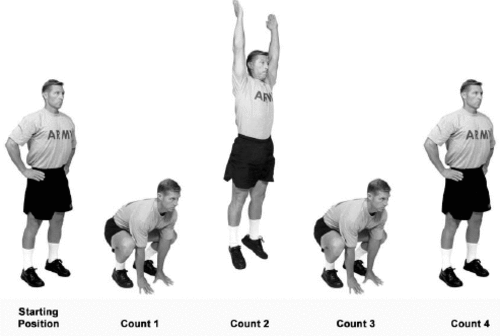Power jump exercises are plyometric movements that require an explosive thrust upwards from a crouched position.
- This plyometric move requires explosive thrusting upwards from a crouched position using lower body muscle groups such as the quadriceps, glutes, hamstrings, and calves.
Power Jumps engage aerobic and anaerobic energy systems throughout one’s body, thus providing benefits such as increased speed, agility, and endurance and potentially boosting overall athletic performance.
- Power Jump exercises are also versatile in intensity; adjusting factors like height or repetitions can alter how challenging they are for individuals.
- Learning how to land correctly with soft knees is important to avoid joint problems.
Army PRT Power Jump Exercise
The Power exercise is the 1st workout in Conditioning Drill 1 Exercises.
Purpose:
- This exercise reinforces correct jumping and landing, stimulates balance and coordination, and develops explosive strength (Figure 9-2).
Starting Position:
- Straddle stance with hands on hips.
Cadence:
- MODERATE
Count:
- Squat with the heels flat as the spine rounds forward to allow the straight arms to reach the ground, attempting to touch with the palms of the hands.
- Jump forcefully in the air, vigorously raising arms overhead, with palms facing inward.
- Control the landing and repeat count 1.
- Return to the starting position.

Check Points:
- At the starting position, tighten the abdominals to stabilize the trunk.
- Keep the back generally straight on counts 1 and 3 with the head up and the eyes forward.
- On count 2, the arms should be extended fully overhead. The trunk and legs should also be in line.
- On each landing, the feet are directed forward and maintained at shoulder distance apart. The landing should be “soft” and proceed from the balls of the feet to the heels. The vertical line from the shoulders through the knees to the balls of the feet should be demonstrated on each landing.
Benefits of Power Jump Exercise
Power jump exercises are an excellent choice if you’re looking to engage multiple muscle groups and improve overall fitness levels! These workouts:
- Primarily target the legs, glutes, and core, among other muscles.
- Provide high-intensity workout sessions, promoting faster calorie loss and consistently elevated heart rates, boosting endurance.
- Enhance lower body strength due to the engagement of fast-twitch fibers, standard in powerful movements like those involved in power jumps.
- Improve cognitive functioning over time by requiring focus, balance control, and coordination.
How to Do Power Jumps at Home
Including Power Jumps in my workout routine has improved my muscular strength, endurance, and cardiovascular health.
Not only have I gotten my desired physical attributes, but I have also improved my overall athletic performance quite a bit, which is ideal for anyone who has set fitness targets steadfastly in mind!
The following steps outline how we can best perform power jumps:
- Take the starting position beneath yourself with shoulder-width-spaced legs.
- Lower yourself down slowly while keeping your back straight, bending from hip & knee joints until you settle down, catching up with good posture.
- With enthused energy, launch yourself upward, simultaneously extending both legs as high up off the ground as possible while pushing off forcefully from both feet’s balls.
- Land cautiously as both feet settle down gently right where you started.
Remember to use proper form for safety and minimize injury risks; e.g., tightness around our core area creates better stability during landings.
Pros and Cons of the Power Jump Exercise
Like any exercise routine, power jumps have benefits and potential drawbacks that warrant consideration.
Pros:
- Power jumps activate multiple muscle groups simultaneously, allowing for robust calorie burning in shorter periods of time.
- These plyometric workouts increase cardiovascular fitness by raising heart rates and improving blood circulation.
Cons:
- Improper technique execution during training sessions could lead to injuries, such as sprained ankles or knee joints hurt from impact trauma when landing too hard.
- Newer trainees often need help with the coordination and balance required for power jumps.
Conclusion
- The power jump exercise is ideal if you are searching for an exciting yet effective way to boost your overall fitness level.
- This plyometric exercise doesn’t just stimulate your heart rate but also works out multiple lower body muscles.
- Whether you’re an athlete hoping to improve their performance or seeking variety in your workout routine, power jumps can be a practical and invigorating option.
- Power Jump exercises are also versatile in intensity; adjusting factors like height or repetitions can alter how challenging they are for individuals.
- Incorporating power jumps into your regular fitness routine is a rewarding and fruitful way to test yourself while gaining strength and endurance across multiple muscle groups.
- Empowering Transactions: Navigating Firearms Sales with Proper Documentation - April 8, 2024
- Army PRT – Preparation and Recovery 2024 - March 18, 2024
- Active and Reserve Components 2024 - March 6, 2024
